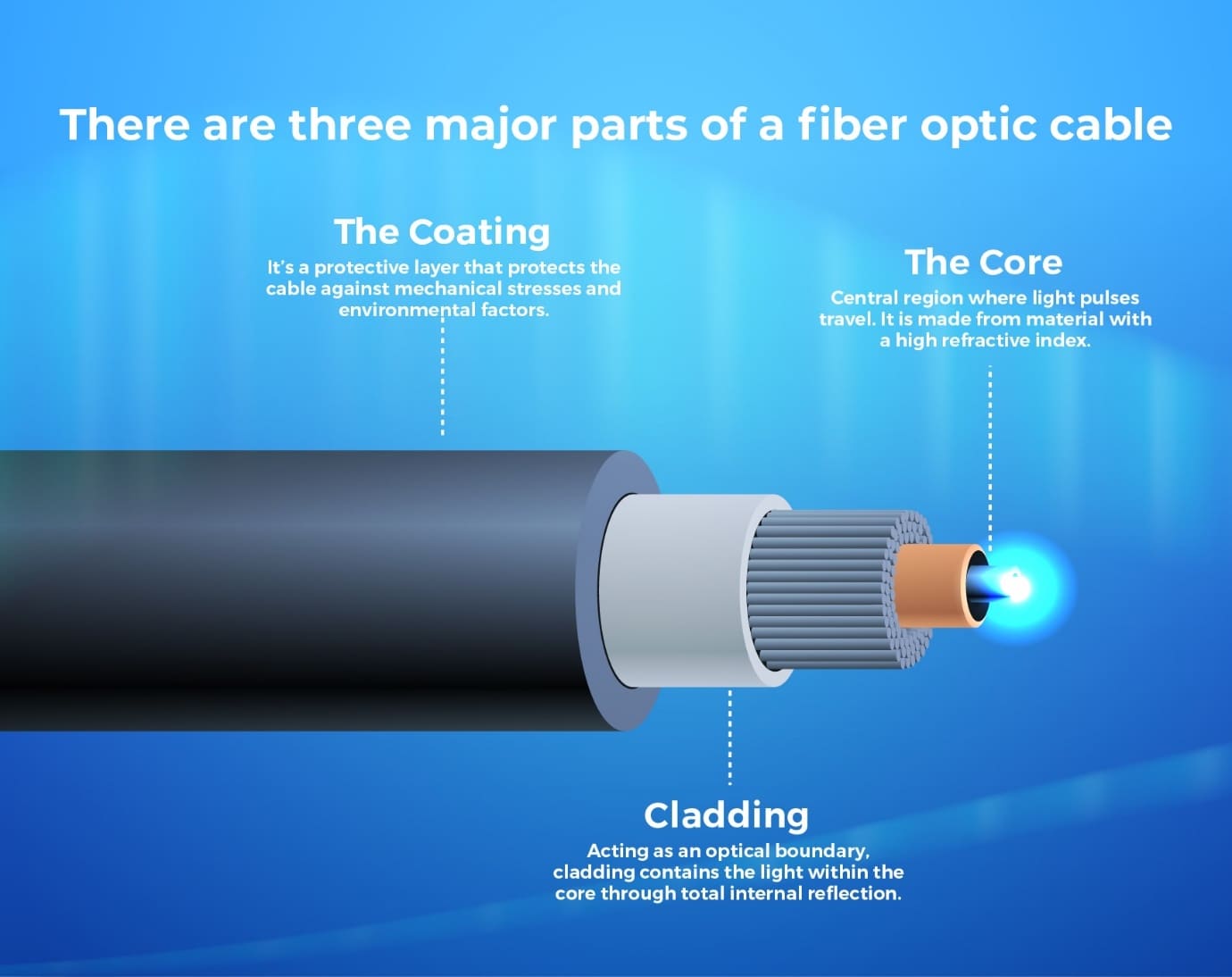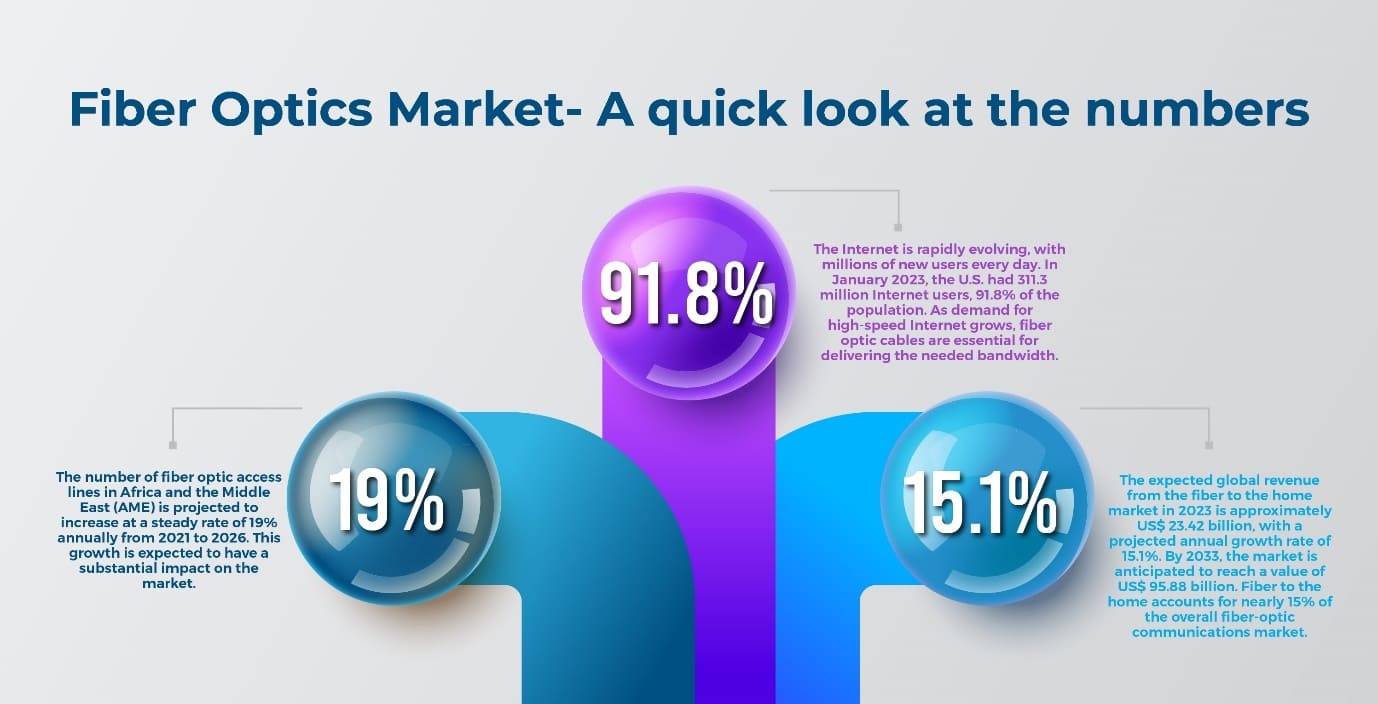Have you come across the "Songdo International Business District" in South Korea? While it may initially seem unrelated to the subject you're exploring, it holds a significant connection. Situated near Incheon, this meticulously planned city stands as a prime example of a smart city, leveraging cutting-edge technologies to enhance the quality of life for its residents and improve the efficiency of several urban systems. The transformative journey of this once inconspicuous city into Korea's Smart City can be attributed to its seamless integration of information technology (IT). This integration relies on the use of fiber optic cables, connecting different components like homes, buildings, schools, hospitals, and retail outlets. From high-speed connectivity to traffic management to smart buildings to public safety and services, fiber optics technology is instrumental in its transformation into a smart city.
Today, the role of fiber optic cables has grown to be incredibly significant across a range of innovative applications including but not limited to Fiber-to-the-Home (FTTH), Fiber-to-the-X (FTTX), Fiber-to-the-Antenna (FTTa), and Fiber-to-the-Node (FTTn). These advanced technologies have harnessed the potential of fiber optics to strengthen connectivity and communication. Let’s delve into the intricacies of fiber optic cable, its working, benefits, and influence on shaping the modern digital world.
Fiber Optic Cable: Understanding the Design

An optical fiber cable consists of three primary components:
The Core:
Analogous to the heart of the cable, the core represents the central region where light pulses travel. It's an incredibly slender thread, akin to a strand of human hair, made from materials with a high refractive index. This core is the path through which light signals are guided. For widely used 250um fiber, the diameter of core is around 9um.
The Cladding:
Surrounding the core is the cladding, acting as an optical boundary. Crafted from a material with a slightly lower refractive index than the core, the cladding's purpose is to contain the light within the core through total internal reflection. This reflective mechanism ensures minimal signal loss over distance. The core and clad together makes the diameter of 125um.
The Coating:
Adding a protective layer, the primary and secondary coating envelops the cladding and core. This outermost layer guards the delicate core and cladding against mechanical stress and environmental factors. The coating is designed to absorb shocks, prevent moisture ingress, and safeguard the integrity of the light transmission pathway. Over diameter of the fiber at this stage is around 250um
Collectively, this intricate architecture operates in synergy. When light is induced into the core, it undergoes controlled reflections off the cladding, effectively 'bouncing' within the core due to the differing refractive indices. This phenomenon enables high-speed, long-distance data transmission with minimal attenuation. Now, the question is why are fiber optic cables used? Let’s find out!
Fiber Optic Cable: Why is it Used?
Optical fiber cables are utilized for a plethora of advantages, driven by their exceptional characteristics:
Data Carrying Capacity
Optical fiber is the most effective way of carrying data available. Each strand of fiber is thinner than a human hair, and yet single-mode fibers can carry up to 32 terrabytes of data per second (TB/s)
High Bandwidth Potential
Fiber optic cables have incredibly high bandwidth capabilities. They can handle a large amount of data at once. This makes them perfect for data-hungry applications, from HD streaming to real-time video conferencing.
Signals that Reach Farther
In the digital landscape, distance poses no threat to signal strength for fiber optic cables. Light pulses travel smoothly across extended distances, requiring minimal signal boosting. This inherent feature not only ensures reliability but also paves the way for efficient long-distance communication.
Interference Resistance - A Clear Advantage
In a world full of electronic noise, fiber optic cable emerges as a silent conductor of information. They effectively block electromagnetic interference, ensuring that your data remains intact or uncorrupted, even in busy electromagnetic environments.
Underwater Communication: Taking the Plunge
Unlike traditional cables, fiber optics excel in underwater environments. They can be submerged in water, opening doors to aquatic data transmission, and making them indispensable for underwater communication systems, marine research, and more.
Maintenance, the Silent Spectator
Fiber optic cables prove that size isn't everything. Thinner and lighter than their copper counterparts, these cables showcase remarkable strength. Their reliability is matched by their longevity – requiring less frequent maintenance and replacement. This translates into fewer disruptions, enhanced operational efficiency, and reduced maintenance costs.

Applications of Fiber Optic Cable:
While fiber optic cables are employed in a multitude of applications, today we will focus on a select few key uses.
Bridging the Digital Divide
Using optical fiber cables for FTTx (Fiber to the x, x can be curbs, premises, buildings, offices, etc.) deployments can narrow the digital divide by extending high-quality and cost-effective internet services to underserved regions, particularly in remote and rural areas where copper infrastructures are frequently insufficient, expensive, or unavailable.
Improving Healthcare
Fiber optic cables play a vital role in modern healthcare by enabling high-speed, long-distance data transmission. This facilitates rapid access to critical patient information like medical images and electronic health records worldwide. Their thin and lightweight design simplifies installation, making them ideal for data-intensive medical technologies such as telemedicine, AI, and robotics, ultimately enhancing healthcare delivery.
Smart City Development
Apart from healthcare, fiber optic cable is the cornerstone of smart city development, providing high-speed connectivity for crucial applications like IoT, traffic management, security, and public Wi-Fi. They enable real-time data collection and analysis, improving urban planning, resource allocation, and service optimization while enhancing the overall quality of life for residents.
Military Applications
There are various use cases of optical fiber in defense. They are integral to advanced weaponry like FOG-M and FOG-S, enhancing communication between missile and operator, and enabling precise targeting. The military also explores fiber optics in systems like PDAMS for rapid ballistic missile defense. Optical technology, including night vision goggles and Fiber Optic Gyroscopes (FOGs), significantly contributes to modern Intelligence, Surveillance, and Reconnaissance (ISR) capabilities, ensuring soldiers have effective tools for mission success.
Gaming and Entertainment
In the realm of gaming and entertainment, fiber optics stand out as a game-changer. These high-speed cables enable seamless, lag-free gaming experiences, especially in competitive esports. Additionally, they support ultra-high-definition streaming and downloads, revolutionizing how we access and enjoy content. Fiber optic networks empower the gaming and entertainment industry to deliver immersive, high-quality experiences that captivate audiences worldwide.
Doing its bit for the Environment
Fiber optics technology offers a double advantage in energy efficiency. Not only do they consume less power in their operation, but they also produce less heat, reducing the demand for cooling compared to copper cable networks. This decreased need for cooling translates into fewer carbon emissions, aligning with sustainable energy practices.
Final Words:
In conclusion, fiber optic cables are not just the backbone of our modern digital world; they are the lifeblood of innovation and progress. Their remarkable ability to transmit vast amounts of data at incredible speeds has transformed industries, bridged gaps in connectivity, and revolutionized the way we live and work. Whether it's enabling life-saving telemedicine, supporting the development of smart cities, or enhancing the precision of military technologies, fiber optics have proven to be indispensable. Moreover, they are paving the way for a more sustainable future by reducing energy consumption and carbon emissions. As we continue to push the boundaries of technology, one thing remains clear: the future is indeed fiber optic cable and its potential is limitless.